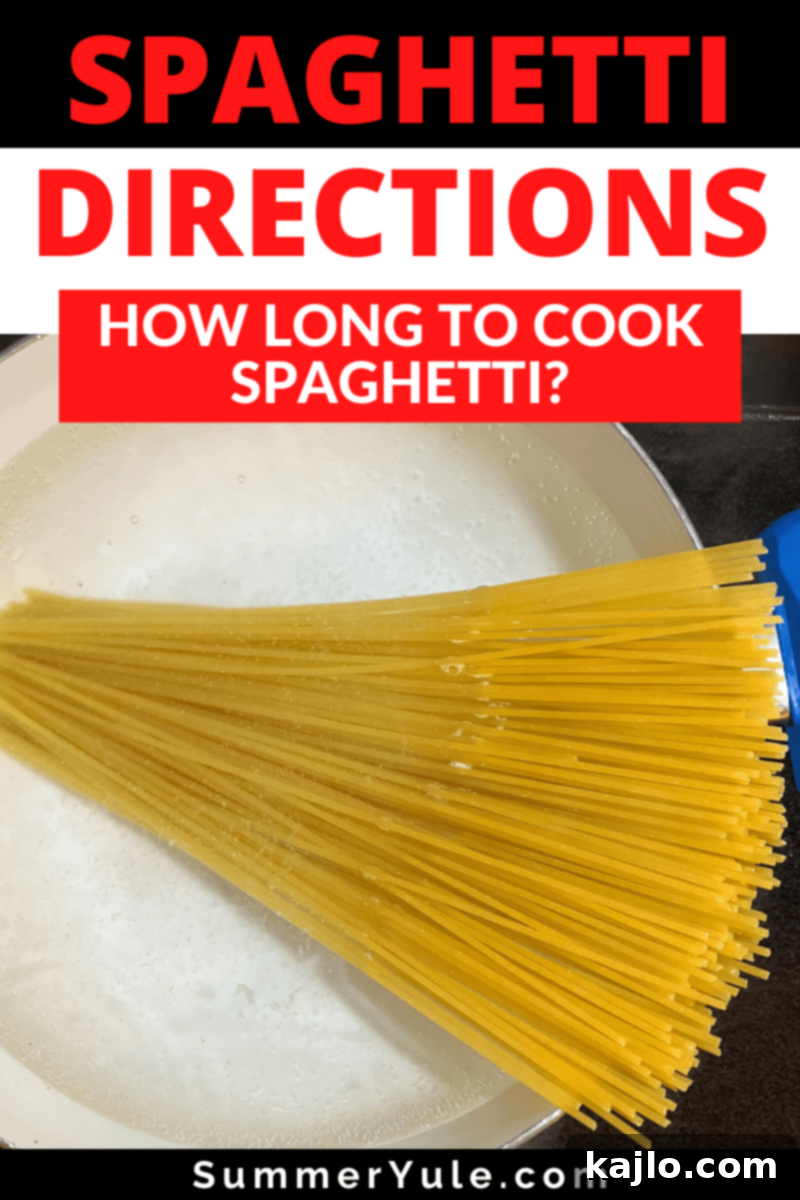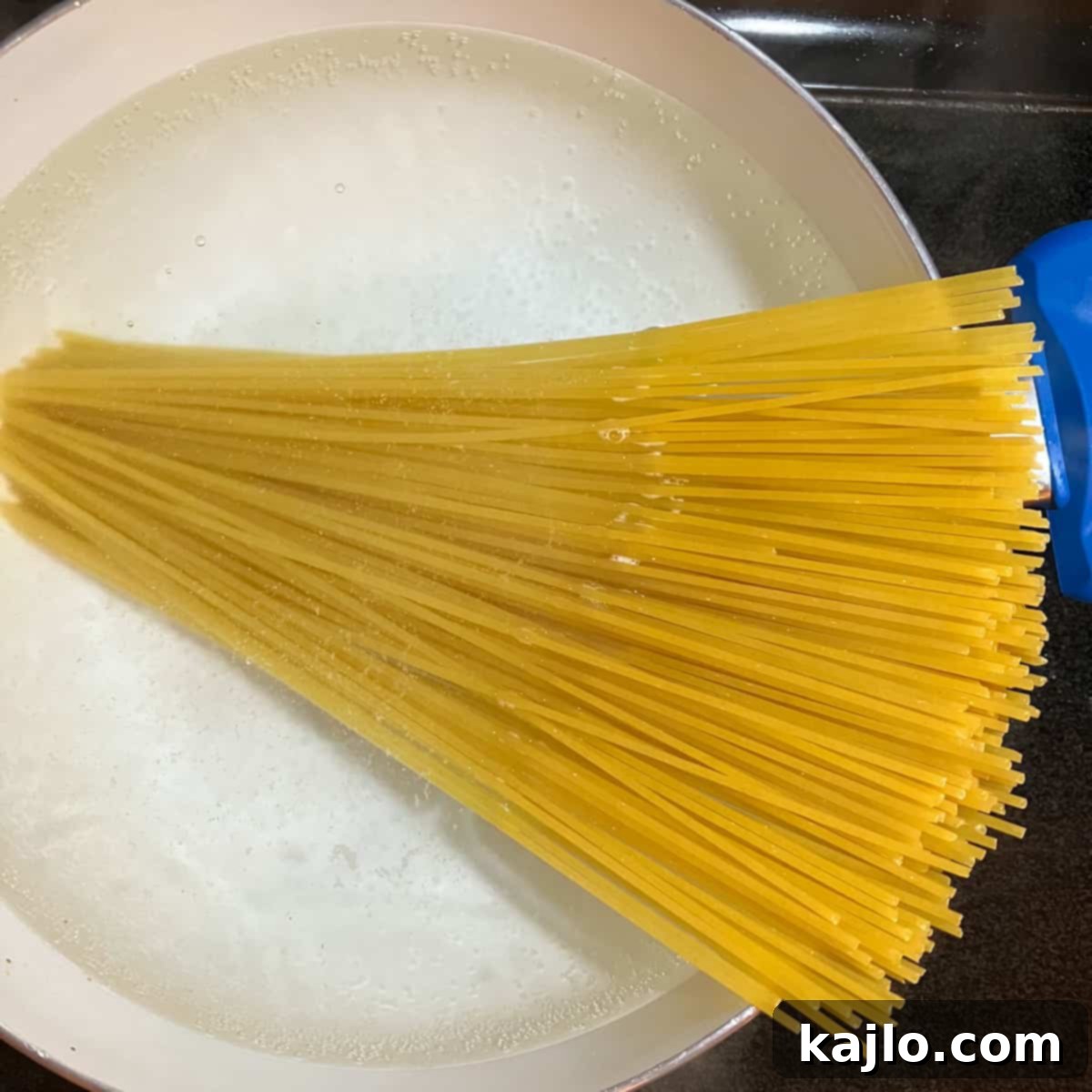Mastering the Art of Spaghetti: Your Ultimate Guide to Perfect Cooking Times
Cooking spaghetti perfectly is an essential skill for any home chef. While it might seem straightforward, achieving that ideal “al dente” texture requires a bit of precision. So, how long to cook spaghetti? Generally, dry spaghetti noodles will be ready in 8-12 minutes in a pot of vigorously boiling water. However, this is just a starting point. This comprehensive guide will equip you with all the knowledge needed to perfect your pasta, whether it’s dry, fresh, or even a healthier alternative like spaghetti squash or zucchini noodles.

The exact spaghetti cooking time can vary significantly based on several factors. These include the pasta’s shape, its composition (whether it’s made from wheat, rice, or chickpeas), and your desired texture, such as a firm al dente or a softer bite. For this reason, the most accurate cooking instructions are almost always found on the pasta packaging itself, as they are tailored to that specific product. But what if the box is missing, or you’re a novice cook seeking more detailed guidance? Fear not, as we’re here to provide step-by-step instructions and invaluable tips to ensure your pasta turns out perfectly every time.
Achieving Al Dente Perfection: How Long to Cook Spaghetti
The term “al dente,” Italian for “to the tooth,” describes pasta that is cooked through but still firm and slightly chewy when bitten. It’s the gold standard for pasta, offering the best texture and preventing it from becoming mushy. If you’re wondering how long to cook spaghetti noodles on the stove to reach this coveted texture, follow these detailed steps:
- Prepare the Pot and Water: Begin by selecting a large pot, ideally one that can comfortably hold 4 quarts (approximately 3.8 liters) of water for every pound (454 grams) of dry spaghetti. This generous amount of water is crucial for even cooking and preventing the pasta from sticking. Bring this water to a rolling boil over medium-high heat. To speed up the boiling process, you can cover the pot until the water reaches the desired temperature.
- Season the Water: Once the water is boiling, it’s time to add salt. Many culinary experts and Italian traditions recommend using 1-2 tablespoons of salt per pound of pasta. This heavy salting seasons the pasta from the inside out, enhancing its flavor significantly. However, if you are monitoring your sodium intake due to dietary restrictions or health concerns, it’s advisable to omit the salt or use a minimal amount.
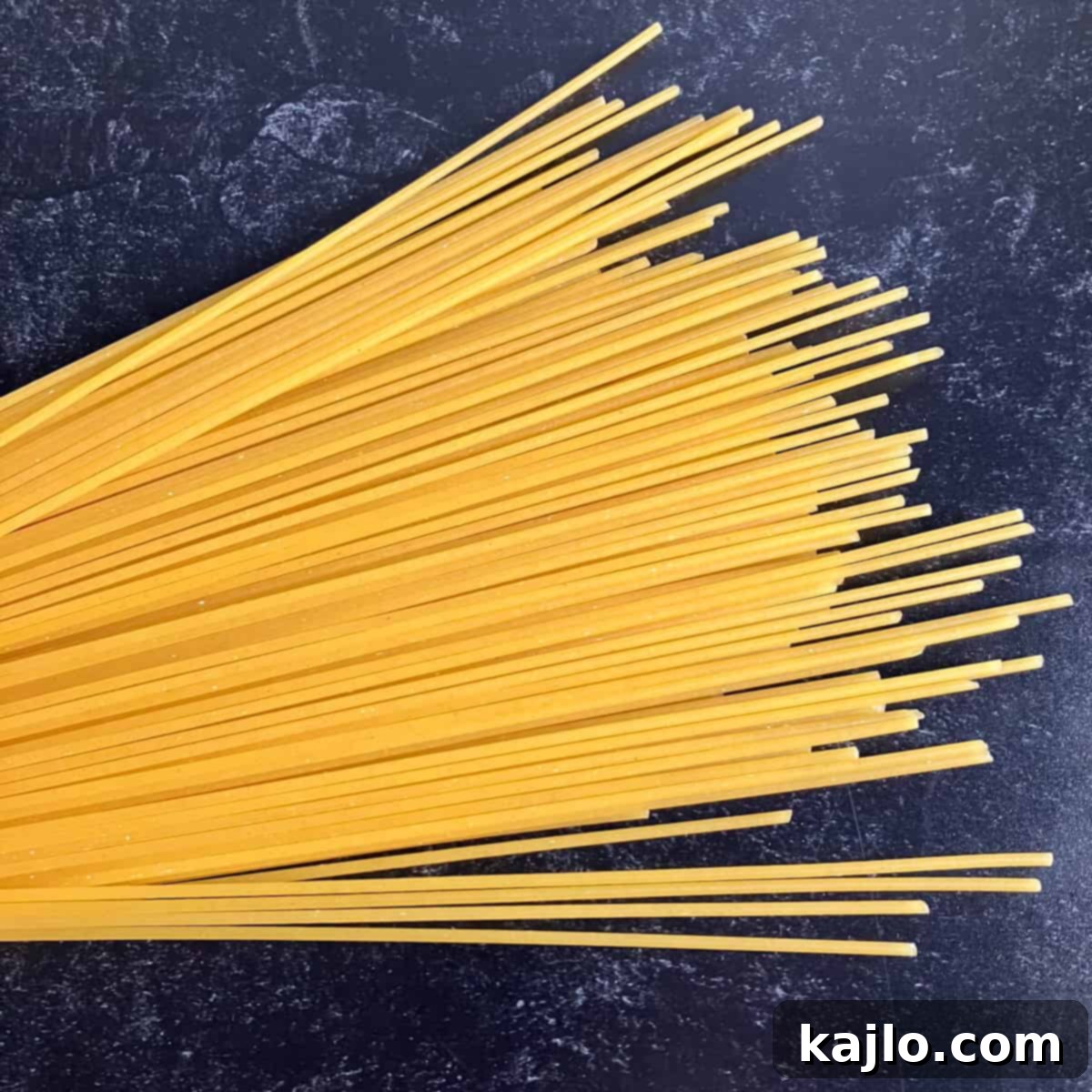
- Add the Spaghetti: Uncover the pot and slowly add the dry spaghetti noodles. As you add them, gently push them down into the boiling water using a spaghetti spoon or tongs. Long strands of spaghetti can be rigid at first, but they will quickly soften and become pliable enough to be fully submerged. Keep the noodles moving during the initial minute or two to prevent them from clumping together.
- Boil and Stir: Keep the pot uncovered to prevent the water from boiling over and to allow for proper evaporation, which helps with starch concentration. Allow the water to return to a full boil after adding the pasta. Cook the spaghetti for 8-12 minutes, stirring occasionally. Frequent stirring is key to preventing the noodles from sticking to each other or to the bottom of the pot. For a perfect al dente texture, aim for a cooking time of 10-11 minutes. It’s always a good idea to taste a strand a minute or two before the estimated time to ensure it reaches your preferred firmness.
- Drain and Serve: Once the spaghetti has reached your desired doneness, promptly remove it from the heat. Drain the pasta using a colander, but resist the urge to rinse it under cold water. The starchy pasta water is often a secret ingredient in many Italian sauces, helping the sauce adhere better to the pasta and creating a richer consistency. You might want to reserve about a cup of this pasta water before draining, just in case your sauce needs a little loosening. Immediately toss the drained spaghetti with your favorite sauce and serve for the best flavor and texture.
Should You Cover Pasta While Cooking?
While covering the pot helps the water come to a boil faster before adding the pasta, you should generally avoid covering the pasta once it’s actively cooking. Leaving the pot uncovered allows the steam to escape, preventing the water from boiling over and ensuring more consistent cooking. It also helps in maintaining the water temperature more steadily.
Is It Necessary to Boil Water Before Adding Pasta?
Yes, for most traditional pasta recipes, it is crucial to bring the water to a rolling boil before adding the pasta. Adding pasta to cold or lukewarm water will result in gummy, unevenly cooked noodles. The immediate high heat helps to set the pasta’s starch, preventing it from clumping and ensuring a more even cook.
Should Oil Be Added to Pasta Water?
Contrary to a common misconception, adding oil to pasta water is largely ineffective and often a waste. Olive oil or other oils simply float on top of the water and do not significantly prevent the pasta from sticking together. Moreover, adding oil to the pasta after it’s cooked can create a slick surface, making it difficult for delicious sauces to cling to the noodles. Proper stirring during the initial cooking phase and using enough water are far more effective ways to prevent sticking.
Do Italians Salt Their Pasta Water Heavily?
Absolutely! According to many Italian culinary traditions, pasta water is indeed salted quite generously. This practice is vital for seasoning the pasta itself, ensuring that every strand is flavorful, not just the sauce it’s paired with. Adding 1-2 tablespoons of salt per pound (454g) of dried pasta is a common recommendation. However, as noted earlier, those on low-sodium diets should adjust accordingly.
How to Prevent Sticky Spaghetti?
The key to avoiding sticky, clumpy spaghetti lies in two main actions: using ample water and consistent stirring. After adding the spaghetti to boiling water, the pasta releases starch, which can cause the strands to stick together. Stirring frequently, especially during the first few minutes of cooking, helps to separate the noodles and disperse the starch. A large pot also ensures that the pasta has enough space to move freely, further minimizing stickiness.
How to Keep Spaghetti from Sticking After Draining?
Once drained, spaghetti can quickly clump together. The best way to prevent this is to immediately toss it with your chosen sauce. The sauce coats the noodles, keeping them separate and infusing them with flavor. Avoid rinsing the pasta after draining, as this removes the beneficial surface starch that helps the sauce adhere. Similarly, unless you’re specifically making buttered pasta, adding oil or butter after draining can create a barrier that prevents the sauce from properly coating the noodles.
Why Do Some Recommend Cooking Pasta in Cold Water?
While traditional methods dictate boiling water, some alternative techniques, like Alton Brown’s cold water pasta method, suggest starting pasta in cold water. This method can potentially be faster and results in extra-starchy pasta water, which can be fantastic for emulsifying and enriching pasta sauces. It’s an interesting approach worth experimenting with, though the boiling water method remains the most widely accepted and reliable for consistent results.
Choosing the Best Pot for Cooking Spaghetti
The most important feature of a pasta pot is its size. It needs to be large enough to accommodate both the pasta and the recommended amount of water without overflowing. As a general rule, a 6-8 quart pot (or even larger) is ideal for cooking a pound of spaghetti with 4 quarts of water. A good pasta pot ensures ample space for the noodles to cook evenly and prevents them from sticking. Many modern pasta pots come with convenient features like strainer lids, making draining much easier.
Cooking Long Spaghetti Without Breaking It
Breaking long spaghetti noodles before cooking is often considered a culinary faux pas. To cook them whole, simply add them to the boiling water, allowing the ends to soften and submerge gradually. Use a spaghetti spoon or tongs to gently nudge and coil the softening strands into the water. Within a minute or two, they will become flexible enough to be fully immersed. This gentle manipulation also helps prevent individual pieces from sticking together.

🍝 A Comprehensive Pasta Cooking Time Chart
Understanding the cooking times for various pasta shapes is crucial for diverse culinary adventures. This chart provides estimated cooking times for common types of dried pasta in salted boiling water. Always remember that these are guidelines; for the most precise results, always consult the specific instructions on your pasta packaging.
| Type of Pasta | How Long to Cook |
|---|---|
| Bowties (Farfalle) | 8-15 minutes |
| Fettucine | 8-13 minutes |
| Gluten-Free Pasta | 6-10 minutes |
| Large Pasta Shells | 9-12 minutes |
| Lasagna Noodles | 11-15 minutes |
| Linguine Noodles | 9-13 minutes |
| Macaroni | 9-12 minutes |
| Manicotti | 10-12 minutes |
| Pappardelle Pasta | 7-10 minutes |
| Penne | 10-13 minutes |
| Ravioli (frozen) | 4-9 minutes |
| Rigatoni | 10-15 minutes |
| Rotini | 8-12 minutes |
| Small Pasta Shells | 8-12 minutes |
| Spaghetti | 8-12 minutes |
| Thin Spaghetti Noodles (Angel Hair) | 3-5 minutes |
| Tortellini (frozen) | 4-9 minutes |
| Vermicelli Pasta | 2-3 minutes |
| Ziti | 9-15 minutes |
When preparing pasta for a baked dish or casserole, it’s wise to slightly undercook it (parboil) by a few minutes. This prevents the pasta from becoming overly soft or mushy during its subsequent time in the oven. Conversely, for cold pasta salads, some chefs prefer to cook the pasta a little longer, as more tender noodles can absorb salad dressing more effectively, resulting in a richer flavor.
How Long to Cook Whole Wheat Spaghetti?
Whole wheat pasta often has a slightly different texture and cooking behavior compared to traditional white flour pasta. It tends to soften more quickly. For dry whole wheat spaghetti, start checking for doneness after 7-8 minutes, and extend the boiling time if a softer texture is preferred. Always taste to ensure it’s cooked to your liking.
Microwave Spaghetti: A Quick Fix
While not ideal for the best texture, cooking spaghetti in the microwave is a viable option when your stove is unavailable or you need a quick solution. To do this, place dry spaghetti and enough water to cover it completely in a large, microwave-safe bowl. Microwave on high for 11-14 minutes, pausing halfway through to stir the pasta and check its doneness. This method prioritizes convenience over gourmet texture, but it certainly gets the job done.
Instant Pot Spaghetti Cooking Times
The Instant Pot offers a convenient, one-pot solution for spaghetti. Many recipes, like this one for Instant Pot spaghetti and meat sauce, combine cooking the dry pasta and sauce together under high pressure. This method significantly reduces overall cooking time and cleanup, making it perfect for busy weeknights.
Slow Cooker Spaghetti: A Set-It-and-Forget-It Approach
For a truly hands-off approach, the slow cooker can also be used to prepare dry spaghetti. Recipes such as this Crock Pot spaghetti demonstrate how to cook the pasta and meat sauce simultaneously, resulting in a comforting one-pot meal with minimal effort.
🤔 How Do You Know When Spaghetti is Done?
The most reliable method for determining spaghetti doneness is to simply taste it. Properly cooked al dente pasta should be tender yet firm to the bite, with a slight resistance and chewiness. It should not be hard in the center, nor should it be mushy. It’s important to note that while dry pasta can achieve an al dente texture, fresh pasta or homemade pasta dough, due to its different composition and moisture content, will not typically reach the same firm al dente consistency.
Can Pasta Be Overcooked?
Absolutely! Overcooking pasta is a common mistake, particularly in some Western cuisines. Overcooked pasta loses its desirable texture, becoming gummy, soft, and ultimately mushy. This is a culinary misstep rarely encountered in authentic Italian cooking, where the al dente standard is strictly adhered to. The best way to prevent overcooked pasta is to pay close attention to the recommended cooking times, use a timer, and, most importantly, taste a strand periodically during the final minutes of cooking.
💡 How Long to Cook Fresh Pasta
Fresh pasta, whether homemade or store-bought, cooks significantly faster than its dried counterpart. Typically, fresh pasta only requires 1½-4 minutes to cook, depending on its thickness and your desired level of doneness. Because it cooks so quickly, it’s crucial to stay vigilant and taste it frequently to prevent overcooking and achieve the perfect texture.
⭐ How Long to Cook Spaghetti Bolognese
The cooking time for a classic Spaghetti Bolognese primarily refers to the sauce, not the pasta itself, which is typically cooked separately. Most easy Bolognese recipes call for a sauce simmer time of 45-60 minutes. This usually breaks down into 15-30 minutes for sautéing vegetables and browning meat, followed by 30 minutes of simmering to allow the flavors to meld. More traditional and complex Bolognese recipes often involve simmering the sauce for 3-6 hours, or even longer, for a truly rich and deep flavor profile. For a quicker alternative, consider an Air Fryer Spaghetti Bolognese recipe.
How Long to Cook Spaghetti Sauce
The cooking time for spaghetti sauce varies widely. A pre-made jarred sauce can be heated through on the stove in just 5-10 minutes. However, homemade spaghetti sauces benefit immensely from longer simmer times, which allow the ingredients to meld and deepen in flavor. Many homemade pasta sauce recipes recommend simmering for 1-4 hours, with some traditional recipes extending to even longer durations for maximum richness.
🔥 How Long to Cook Spaghetti Squash
Spaghetti squash offers a fantastic low-carb, gluten-free alternative to traditional pasta. The cooking time depends primarily on the size of the squash. An average spaghetti squash typically takes about 40 minutes to become tender when baked in an oven preheated to 400°F (200°C). For best results, split the squash in half lengthwise, scoop out the seeds, and brush the cut halves with a little oil to encourage some caramelization. For an incredibly fast method, try an Air Fryer Spaghetti Squash Recipe.
Microwave Spaghetti Squash in Minutes
For a super-fast spaghetti squash, the microwave is your friend. First, pierce the squash all over with a fork or knife to prevent it from exploding during cooking. Place it in a microwave-safe bowl with a few tablespoons of water. Microwave on high for 6-7 minutes, then check for tenderness. Continue microwaving in shorter intervals until the flesh is soft enough to easily shred into spaghetti-like strands.
Instant Pot Spaghetti Squash: Effortless and Quick
The Instant Pot makes cooking spaghetti squash incredibly simple and fast. Detailed directions for Instant Pot spaghetti squash can help you achieve perfectly cooked squash in a fraction of the time compared to oven baking. This is an excellent method for quickly preparing this versatile vegetable.
😋 How Long to Cook Spaghetti and Meatballs
A classic spaghetti and meatballs dish typically involves cooking the pasta and meatballs separately, then combining them. Recipes like Rachael Ray’s popular spaghetti and meatballs recipe can be made in about 20 minutes, not including sauce simmer time. The pasta cooks in its standard 8-12 minutes, and if you’re looking for a quick meatball solution, cooking Frozen Meatballs in an Air Fryer can have them ready in roughly the same amount of time as boiling your spaghetti.
🌡️ How Long Does Cooked Spaghetti Last in the Fridge?
Proper storage is essential for food safety and quality. Cooked spaghetti, when stored correctly in an airtight container, can be safely kept in the refrigerator for up to 3-4 days (source). Always ensure it’s cooled quickly before refrigerating to prevent bacterial growth.
🥶 How Long Can You Freeze Spaghetti?
If you’ve made a large batch, cooked spaghetti can be frozen for up to 1-2 months (source). However, it’s worth noting that freezing and thawing pasta can sometimes alter its texture, making it softer or a bit mushy. For the best culinary experience, freshly cooked spaghetti is always preferred.
👨🍳 Delicious Spaghetti Recipes and Pairings
Once you’ve mastered the perfect spaghetti cooking time, the possibilities are endless. Here are some fantastic recipes for spaghetti and accompanying sauces to inspire your next meal:
- Keto Pesto Sauce Recipe: A flavorful, low-carb pesto that pairs beautifully with spaghetti or zucchini noodles.
- High-Calorie Pasta with Mushrooms for Weight Gain: A rich and satisfying dish for those looking to boost their calorie intake.
- Tahini Pasta Sauce: An unconventional yet delicious and creamy sauce for a unique pasta experience.
- Tempeh Bolognese Sauce: A hearty and healthy vegan alternative to traditional Bolognese.
- Halloween Spaghetti (Poppyseed Butter Noodles): A fun and festive dish perfect for seasonal celebrations.
- Keto Cheese Sauce: A versatile, low-carb cheese sauce that can elevate any pasta dish.
FAQs: Your Common Spaghetti Queries Answered
Can Raw Spaghetti Be Cooked Directly in Sauce?
Yes, cooking dried spaghetti directly in the sauce is a fantastic time-saver and often results in easier cleanup. This method allows the pasta to absorb the rich flavors of the sauce as it cooks. Recipes for both Instant Pot and Crockpot dried spaghetti with sauce can be found above. Additionally, this speedy stovetop spaghetti and sauce recipe provides instructions for a convenient one-pan meal.
Are Spaghetti and Noodles the Same Thing?
While often used interchangeably in everyday conversation, there’s a subtle distinction. According to Merriam-Webster, noodles are broadly defined as “a food paste made usually with egg and shaped typically in ribbon form.” Spaghetti, on the other hand, is specifically “pasta made in thin solid strings.” Traditional spaghetti is typically made from durum wheat and water, without egg. However, given the culinary landscape, “noodles” and “spaghetti” frequently refer to similar long, thin pasta shapes.
How to Cook Frozen Spaghetti?
The simplest and most recommended way to reheat frozen cooked spaghetti is in the microwave until it is thoroughly thawed and heated. This method helps to prevent burning or crisping the pasta, which can happen with stovetop or oven reheating. Once defrosted and warm, you can then add your sauce and continue heating briefly to combine the flavors.
How to Cook Fried Spaghetti?
Fried spaghetti offers a unique textural experience, differing from simply reheating. This highly-rated fried spaghetti recipe involves actually frying cooked spaghetti in a skillet, often with a generous amount of cheese, resulting in a delightfully crispy and flavorful dish. It’s a departure from conventional pasta preparation, creating a new way to enjoy spaghetti.
How Long to Cook Zucchini Noodles?
Zucchini noodles, or “zoodles,” are a popular low-carb pasta alternative. Fresh zucchini noodles cook very quickly. In a skillet, they typically only need 2-4 minutes to heat through and become tender-crisp, as detailed in this Air Fryer Turkey Meatballs with Zucchini Noodles recipe. For microwave preparation, try 1-2 minutes on high, adding additional time in short bursts until they reach your desired tenderness, careful not to overcook and make them watery.
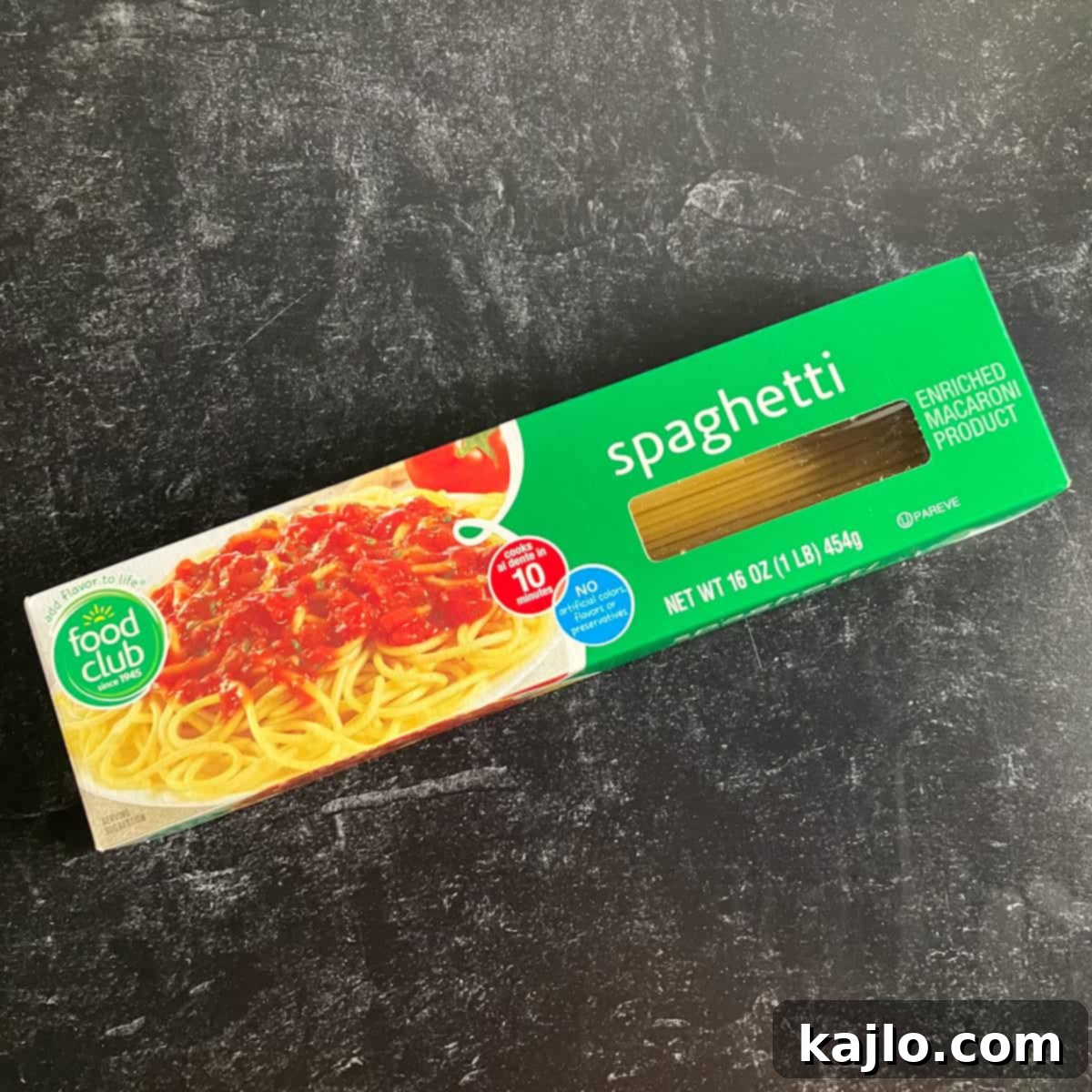
Watch How to Make It!
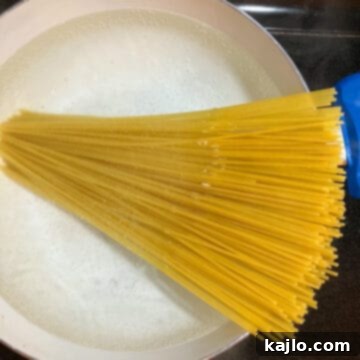
How Long to Cook Spaghetti (Boil Pasta Time)
Summer Yule
Print Recipe
Pin Recipe
Ingredients
- 1 lb. spaghetti (454 grams dry pasta noodles)
- 1-2 tablespoons salt (optional, for seasoning pasta water)
Instructions
- In a large pot, bring 4 quarts of water per pound of dry spaghetti to a rolling boil over medium-high heat. Covering the pot can help water boil faster.
- Add 1-2 tablespoons of salt to the boiling water, if desired, for seasoning the pasta.
- Once the water is boiling, uncover the pot and slowly add the spaghetti. Gently stir the noodles with a spoon or tongs until they soften enough to be fully submerged and are separated.
- Keep the pot uncovered, allow the water to return to a boil, and cook the spaghetti for 8-12 minutes until tender. Stir occasionally to prevent sticking. For al dente spaghetti, a 10-11 minute cook time is generally best. Taste a strand to confirm doneness.
- Drain the spaghetti immediately using a colander. Do not rinse the pasta. (If your sauce requires it, reserve about 1 cup of pasta water before draining.) Toss the hot pasta with your favorite sauce right away and serve.
Save this RecipeSaved!
Equipment
- Pasta Pot
- Tongs
Notes
💭 Expert Tips from Dietitian Summer Yule
This is a level 3 recipe (suitable for weight maintenance and active lifestyles). Spaghetti, while delicious, is a carbohydrate-dense food where portion control is often overlooked. A food scale or a dedicated spaghetti measuring tool can be incredibly helpful in visualizing and measuring appropriate pasta portions. (Here’s a fun option!)
A standard serving of dry spaghetti is typically 2 ounces (57g), equating to approximately 200 calories. This guideline is general; individuals with higher energy needs, such as athletes, may require larger portions. By complementing your spaghetti with other food groups like a hearty meat sauce, a sprinkle of cheese, and a generous side salad, you can create a balanced and nutritious meal.
A common pitfall is consuming excessively large portions of pasta while neglecting vegetables and protein. Remember, a 1-lb box of pasta yields eight servings when combined with other fulfilling components of a meal. Focusing on incorporating diverse, healthy foods alongside your pasta makes the specific serving size of grains less restrictive and more enjoyable.
Note: The nutrition information provided is for a 2-ounce (57g) portion of dry spaghetti, measured prior to cooking.
nutrition info disclaimer
All recipes and dietary advice on this website may or may not be appropriate for you, depending on your individual medical needs and personal preferences. It is always recommended to consult with a registered dietitian or your physician if you require personalized guidance in determining the most suitable dietary pattern for your health goals.
The nutrition information presented here is an estimate provided for your convenience. Actual nutritional values may vary based on the specific brands and ingredients you use. Please also note that calorie information on food labels can sometimes be approximate, so it’s best not to overly stress about exact numbers.
The instruction “to taste” implies adjusting seasoning to your personal preference. Always ensure that food is cooked to safe internal temperatures, especially when tasting, to adhere to food safety guidelines. Avoid consuming undercooked food.
Nutrition
Join our thriving culinary community! Subscribe today for the latest and most delicious recipes, and connect with us on Facebook, Pinterest, Instagram, and YouTube!
